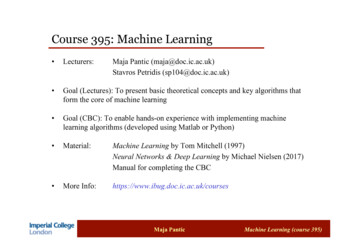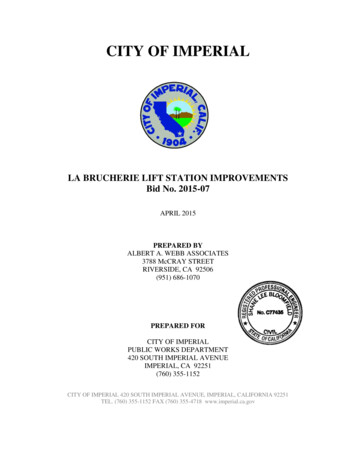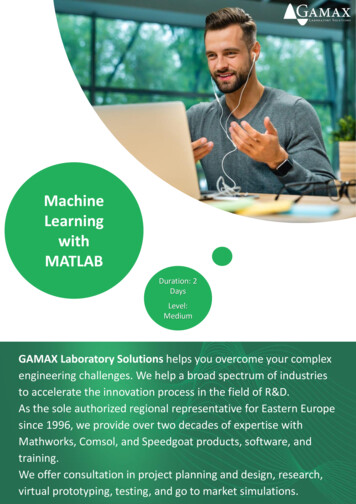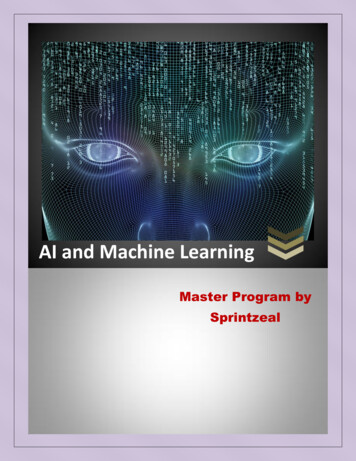
Transcription
Course 395: Machine Learning Lecturers:Maja Pantic (maja@doc.ic.ac.uk)Stavros Petridis (sp104@doc.ic.ac.uk) Goal (Lectures): To present basic theoretical concepts and key algorithms thatform the core of machine learning Goal (CBC): To enable hands-on experience with implementing machinelearning algorithms (developed using Matlab or Python) Material:Machine Learning by Tom Mitchell (1997)Neural Networks & Deep Learning by Michael Nielsen (2017)Manual for completing the CBC More Info:https://www.ibug.doc.ic.ac.uk/coursesMaja PanticMachine Learning (course 395)
Course 395: Machine Learning – Lectures Lecture 1-2: Concept Learning (M. Pantic) Lecture 3-4: Decision Trees & CBC Intro (M. Pantic & S. Petridis) Lecture 5-6: Evaluating Hypotheses (S. Petridis) Lecture 7-8: Artificial Neural Networks I (S. Petridis) Lecture 9-10: Artificial Neural Networks II (S. Petridis) Lecture 11-12: Artificial Neural Networks III (S. Petridis) Lecture 13-14: : Instance Based Learning & Genetic Algorithms (M. Pantic)Maja PanticMachine Learning (course 395)
Course 395: Machine Learning - CBC Lecture 1-2: Concept Learning Lecture 3-4: Decision Trees & CBC Intro Lecture 5-6: Evaluating Hypotheses Lecture 7-8: Artificial Neural Networks I Lecture 9-10: Artificial Neural Networks II Lecture 11-12: Artificial Neural Networks III Lecture 13-14: Instance Based Learning & Genetic AlgorithmsMaja PanticMachine Learning (course 395)
Course 395: Machine LearningNOTECBC accounts for 33.3% of the final grade for the Machine Learning Exam.21final grade exam grade exam grade33Maja PanticMachine Learning (course 395)
Course 395: Machine Learning – Lectures Lecture 1-2: Concept Learning! Lecture 3-4: Decision Trees & CBC Intro Lecture 5-6: Evaluating Hypotheses Lecture 7-8: Artificial Neural Networks I Lecture 9-10: Artificial Neural Networks II Lecture 11-12: Artificial Neural Networks III Lecture 13-14: Instance Based Learning & Genetic AlgorithmsMaja PanticMachine Learning (course 395)
Concept Learning – Lecture Overview Why machine learning? Well-posed learning problems Designing a machine learning system Concept learning task Concept learning as Search Find-S algorithm Candidate-Elimination algorithmMaja PanticMachine Learning (course 395)
Machine Learning Learning Intelligence(Def: Intelligence is the ability to learn and use concepts to solve problems.) Machine Learning Artificial Intelligence– Def: AI is the science of making machines do things that requireintelligence if done by men (Minsky 1986)– Def: Machine Learning is an area of AI concerned with development oftechniques which allow machines to learn Why Machine Learning? Why Artificial Intelligence?Maja PanticMachine Learning (course 395)
Machine LearningMaja PanticMachine Learning (course 395)
Machine LearningMaja PanticMachine Learning (course 395)
Machine LearningMaja PanticMachine Learning (course 395)
Machine Learning Learning Intelligence(Def: Intelligence is the ability to learn and use concepts to solve problems.) Machine Learning Artificial Intelligence– Def: AI is the science of making machines do things that requireintelligence if done by men (Minsky 1986)– Def: Machine Learning is an area of AI concerned with development oftechniques which allow machines to learn Why Machine Learning? Why Artificial Intelligence? To build machines exhibiting intelligent behaviour (i.e., able to reason,predict, and adapt) while helping humans work, study, and entertainthemselvesMaja PanticMachine Learning (course 395)
Machine Learning Machine Learning Artificial Intelligence Machine Learning Biology (e.g., Neural Networks, Genetic Algorithms) Machine Learning Cognitive Sciences (e.g., Case-based Reasoning) Machine Learning Statistics (e.g., Support Vector Machines) Machine Learning Probability Theory (e.g., Bayesian Networks) Machine Learning Logic (e.g., Inductive Logic Programming) Machine Learning Information Theory (e.g., used by Decision Trees)Maja PanticMachine Learning (course 395)
Machine Learning Human Learning Machine Learning– human-logic inspired problem solvers (e.g., rule-based reasoning)– biologically inspired problem solvers (e.g., Neural Networks) supervised learning - generates a function that maps inputs to desired outputs unsupervised learning - models a set of inputs, labelled examples are not available– learning by education (e.g., reinforcement learning, case-based reasoning) General Problem Solvers vs. Purposeful Problem Solvers– emulating general-purpose human-like problem solving is impractical– restricting the problem domain results in ‘rational’ problem solving– example of General Problem Solver: Turing Test– examples of Purposeful Problem Solvers: speech recognisers, face recognisers,facial expression recognisers, data mining, games, etc. Application domains: security, medicine, education, finances, genetics, etc.Maja PanticMachine Learning (course 395)
Well-posed Learning Problems Def 1 (Mitchell 1997):A computer program is said to learn from experience E with respect to someclass of tasks T and performance measure P, if its performance at tasks in T,as measured by P, improves by experience E. Def 2 (Hadamard 1902):A (machine learning) problem is well-posed if a solution to it exists, if thatsolution is unique, and if that solution depends on the data / experience but itis not sensitive to (reasonably small) changes in the data / experience.Maja PanticMachine Learning (course 395)
Designing a Machine Learning System Target Function V represents the problem to be solved(e.g., choosing the best next move in chess, identifying people,classifying facial expressions into emotion categories) V: D C where D is the input state space and C is the set of classesV: D [-1, 1] is a general target function of a binary classifier Ideal Target Function is usually not known; machine learningalgorithms learn an approximation of V, say V’ Representation of function V’ to be learned should– be as close an approximation of V as possible– require (reasonably) small amount of training data to be learned V’(d) w0 w1x1 wnxn where ‹x1 xn› d D is an input state.This reduces the problem to learning (the most optimal) weights w.Well-posedProblem?Determine type oftraining examplesDetermineTarget FunctionChoose Target F-onRepresentationChoose LearningAlgorithmMaja PanticMachine Learning (course 395)
Designing a Machine Learning System V: D C where D is the input state and C is the set of classesV: D [-1, 1] is a general target function of a binary classifierWell-posedProblem? V’(d) w0 w1x1 wnxn where ‹x1 xn› d D is an input state.This reduces the problem to learning (the most optimal) weights w.Determine type oftraining examples Training examples suitable for the given target function representationV’ are pairs ‹d, c› where c C is the desired output (classification) ofthe input state d D. Learning algorithm learns the most optimal set of weights w (so-calledbest hypothesis), i.e., the set of weights that best fit the trainingexamples ‹d, c›. Learning algorithm is selected based on the availability of trainingexamples (supervised vs. unsupervised), knowledge of the final set ofclasses C (offline vs. online, i.e., eager vs. lazy), availability of a tutor(reinforcement learning). The learned V’ is then used to solve new instances of the problem.DetermineTarget FunctionChoose Target F-onRepresentationChoose LearningAlgorithmMaja PanticMachine Learning (course 395)
Concept Learning Concept learning– supervised, eager learning– target problem: whether something belongs to the target concept or not– target function: V: D {true, false} Underlying idea: Humans acquire general concepts from specific examples(e.g., concepts: beauty, good friend, well-fitting-shoes)(note: each concept can be thought of as Boolean-valued function) Concept learning is inferring a Boolean-valued function from training data concept learning is the prototype binary classificationMaja PanticMachine Learning (course 395)
Concept Learning Task – Notation Concept learning task:– target concept: Girls who Simon likes– target function: c: D {0, 1}– data d D: Girls, each described in terms of the following attributes instances a1 Hair (possible values: blond, brown, black)a2 Body (possible values: thin, average, plump)a3 likesSimon (possible values: yes, no)a4 Pose (possible values: arrogant, natural, goofy)a5 Smile (possible values: none, pleasant, toothy)a6 Smart (possible values: yes, no)error rate– target f-on representation: h c’: ‹a1, a2, a3, a4, a5, a6› {0, 1}– training examples D: positive and negative examples of target function c Aim: Find a hypothesis h H such that ( d D) h(d) – c(d) ε 0, where H is theset of all possible hypotheses h ‹a1, a2, a3, a4, a5, a6›, where each ak, k [1.6], maybe ‘?’ ( any value is acceptable), ‘0’ ( no value is acceptable), or a specific value.h ‹?, ?, ?, ?, ?, ?›h ‹0, 0, 0, 0, 0, 0›Maja Pantich ‹?, ?, yes, ?, ?, ?›Machine Learning (course 395)
Concept Learning as Search Concept learning task:– target concept: Girls who Simon likes– target function: c: D {0, 1}– data d D: Girls, each described in terms of the following attributes instances a1 Hair (possible values: blond, brown, black) ‘?’a2 Body (possible values: thin, average, plump)a3 likesSimon (possible values: yes, no) ‘?’ H 1 4· 4· 3· 4· 4· 3 2305a4 Pose (possible values: arrogant, natural, goofy)a5 Smile (possible values: none, pleasant, toothy) ‘?’h ‹0,0,0,0,0,0›error rate ‘?’a6 Smart (possible values: yes, no)– target f-on representation: h c’: ‹a1, a2, a3, a4, a5, a6› {0, 1}– training examples D: positive and negative examples of target function c Aim: Find a hypothesis h H such that ( d D) h(d) – c(d) ε 0, where H is theset of all possible hypotheses h ‹a1, a2, a3, a4, a5, a6›, where each ak, k [1.6], maybe ‘?’ ( any value is acceptable), ‘0’ ( no value is acceptable), or a specific value.concept learning searching through HMaja PanticMachine Learning (course 395)
General-to-Specific Ordering Many concept learning algorithms utilize general-to-specific ordering of hypotheses General-to-Specific Ordering:– h1 precedes (is more general than) h2 ( d D) (h1(d) 1) (h2(d) 1)(e.g., h1 ‹?, ?, yes,?, ?, ?› and h2 ‹?, ?, yes,?, ?, yes› h1 g h2 )– h1 and h2 are of equal generality ( d D) { [(h1(d) 1) (h2(d) 1)] [(h2(d) 1) (h1(d) 1)] h1 and h2 have equal number of ‘?’ }(e.g., h1 ‹?, ?, yes,?, ?, ?› and h2 ‹?, ?, ?, ?, ?, yes› h1 g h2 )– h2 succeeds (is more specific than) h1 ( d D) (h1(d) 1) (h2(d) 1)(e.g., h1 ‹?, ?, yes,?, ?, ?› and h2 ‹?, ?, yes,?, ?, yes› h2 g h1 )Maja PanticMachine Learning (course 395)
Find-S Algorithm – Example1. Initialise h H to the most specific hypothesis: h ‹a1, ,an›, ( i) ai 0.2. FOR each positive training instance d D, do:FOR each attribute ai, i [1.n], in h, do:IF ai is satisfied by dTHEN do nothingELSE replace ai in h so that the resulting h’ g h, h h’.3. Output hypothesis noneno50blondplumpnonaturaltoothyyesh ‹0,0,0,0,0,0› h d1 h ‹blond, ?, yes, ?, ?, no›Maja PanticMachine Learning (course 395)
Find-S Algorithm Find-S is guaranteed to output the most specific hypothesis h that best fits positivetraining examples.The hypothesis h returned by Find-S will also fit negative examples as long astraining examples are correct.However,– Find-S is sensitive to noise that is (almost always) present in training examples.– there is no guarantee that h returned by Find-S is the only h that fits the data.– several maximally specific hypotheses may exist that fits the data but, Find-Swill output only one.– Why we should prefer most specific hypotheses over, e.g., most generalhypotheses?Maja PanticMachine Learning (course 395)
Find-S Algorithm – Example1. Initialise h H to the most specific hypothesis: h ‹a1, ,an›, ( i) ai 0.2. FOR each positive training instance d D, do:FOR each attribute ai, i [1.n], in h, do:IF ai is satisfied by dTHEN do nothingELSE replace ai in h so that the resulting h’ g h, h h’.3. Output hypothesis noneno50blondplumpnonaturaltoothyyesFind-S h ‹blond, ?, yes, ?, ?, no› BUT h2 ‹blond,?, ?, ?, ?, no fits D as wellMaja PanticMachine Learning (course 395)
Find-S Algorithm – Example1. Initialise h H to the most specific hypothesis: h ‹a1, ,an›, ( i) ai 0.2. FOR each positive training instance d D, do:FOR each attribute ai, i [1.n], in h, do:IF ai is satisfied by dTHEN do nothingELSE replace ai in h so that the resulting h’ g h, h h’.3. Output hypothesis noneno50blondplumpnonaturaltoothyyesFind-S h1 ‹blond, ?, ?, ?, ?, no› YET h2 ‹blond,?, yes, ?, ?, ? fits D as wellMaja PanticMachine Learning (course 395)
Candidate-Elimination Algorithm Find-S is guaranteed to output the most specific hypothesis h that best fits positivetraining examples.The hypothesis h returned by Find-S will also fit negative examples as long astraining examples are correct.However,1. Find-S is sensitive to noise that is (almost always) present in training examples.2. there is no guarantee that h returned by Find-S is the only h that fits the data.3. several maximally specific hypotheses may exist that fits the data but, Find-Swill output only one.4. Why we should prefer most specific hypotheses over, e.g., most generalhypotheses?To address the last three drawbacks of Find-S, Candidate-Elimination was proposedMaja PanticMachine Learning (course 395)
Candidate-Elimination (C-E) Algorithm Main idea: Output a set of hypothesis VS H that fit (are consistent) with data D Candidate-Elimination (C-E) Algorithm is based upon:– general-to-specific ordering of hypotheses– Def: h is consistent (fits) data D ( ‹d, c(d)›) h(d) c(d)– Def: version space VS H is set of all h H that are consistent with D C-E algorithm defines VS in terms of two boundaries:– general boundary G VS is a set of all h VS that are the most general– specific boundary S VS is a set of all h VS that are the most specificMaja PanticMachine Learning (course 395)
Candidate-Elimination (C-E) Algorithm1. Initialise G VS to the most general hypothesis: h ‹a1, ,an›, ( i) ai ?.Initialise S VS to the most specific hypothesis: h ‹a1, ,an›, ( i) ai 0.2. FOR each training instance d D, do:IF d is a positive exampleRemove from G all h that are not consistent with d.FOR each hypothesis s S that is not consistent with d, do:- replace s with all h that are consistent with d, h g s, h g g G,- remove from S all s being more general than other s in S.IF d is a negative exampleRemove from S all h that are not consistent with d.FOR each hypothesis g G that is not consistent with d, do:- replace g with all h that are consistent with d, g g h, h g s S,- remove from G all g being less general than other g in G.3. Output hypothesis G and S.Maja PanticMachine Learning (course 395)
C-E Algorithm – ogantnoneno50blondplumpnonaturaltoothyyesG0 {‹?, ?, ?, ?, ?, ?›} , S0 {‹0, 0, 0, 0, 0, 0›}Maja PanticMachine Learning (course 395)
C-E Algorithm – ogantnoneno50blondplumpnonaturaltoothyyesd1 is positive refine Sno g G0 is inconsistent with d1 G1 G0 {‹?, ?, ?, ?, ?, ?›}add to S all minimal generalizations of s S0 such that s S1 is consistent with d1S1 {‹blond, thin, yes, arrogant, toothy, no›}Maja PanticMachine Learning (course 395)
C-E Algorithm – ogantnoneno50blondplumpnonaturaltoothyyesd2 is negative refine Gno s S1 is inconsistent with d2 S2 S1 {‹blond, thin, yes, arrogant, toothy, no›}add to G all minimal specializations of g G1 such that g G2 is consistent with d2G1 {‹?, ?, ?, ?, ?, ?›}G2 {‹blond, ?, ?, ?, ?, ?› , ‹?, ?, yes, ?, ?, ?› , ‹?, ?, ?, arrogant, ?, ?› ,‹?, ?, ?, ?, toothy, ?›, ‹?, ?, ?, ?, ?, no› }Maja PanticMachine Learning (course 395)
C-E Algorithm – ogantnoneno50blondplumpnonaturaltoothyyesd3 is positive refine Stwo g G2 are inconsistent with d3, i.e., ‹?, ?, ?, arrogant, ?, ?› and ‹?, ?, ?, ?, toothy, ?› G3 {‹blond, ?, ?, ?, ?, ?› , ‹?, ?, yes, ?, ?, ?› , ‹?, ?, ?, ?, ?, no› }add to S all minimal generalizations of s S2 such that s S3 is consistent with d3S2 {‹blond, thin, yes, arrogant, toothy, no›}S3 {‹blond, ?, yes, ?, ?, no›}Maja PanticMachine Learning (course 395)
C-E Algorithm – ogantnoneno50blondplumpnonaturaltoothyyesd4 is negative refine Gno s S3 is inconsistent with d4 S4 S3 {‹blond, ?, yes, ?, ?, no›}add to G all minimal specializations of g G3 such that g G4 is consistent with d4G3 {‹blond, ?, ?, ?, ?, ?› , ‹?, ?, yes, ?, ?, ?› , ‹?, ?, ?, ?, ?, no› }G4 {‹blond, ?, ?, ?, ?, ?› , ‹?, ?, yes, ?, ?, ?› }Maja PanticMachine Learning (course 395)
C-E Algorithm – ogantnoneno50blondplumpnonaturaltoothyyesd5 is negative refine Gno s S4 is inconsistent with d4 S5 S4 {‹blond, ?, yes, ?, ?, no›}add to G all minimal specializations of g G4 such that g G5 is consistent with d5One g G4 is inconsistent with d5, i.e., ‹blond, ?, ?, ?, ?, ?› G4 {‹blond, ?, ?, ?, ?, ?› , ‹?, ?, yes, ?, ?, ?›}G5 {‹?, ?, yes, ?, ?, ?› }Maja PanticMachine Learning (course 395)
C-E Algorithm – ogantnoneno50blondplumpnonaturaltoothyyesOutput of C-E:version space of hypotheses VS H bound withspecific boundary S {‹blond, ?, yes, ?, ?, no›} andgeneral boundary G {‹?, ?, yes, ?, ?, ?› }Output of Find-S:most specific hypothesis h ‹blond, ?, yes, ?, ?, no›Maja PanticMachine Learning (course 395)
C-E Algorithm – ogantnoneno50blondplumpnonaturaltoothyyesOutput of C-E:version space of hypotheses VS H bound withspecific boundary S {‹blond, ?, yes, ?, ?, no›} andgeneral boundary G {‹?, ?, yes, ?, ?, ?› }VS {‹?, ?, yes, ?, ?, ?› , ‹blond, ?, yes, ?, ?, ?› ,‹?, ?, yes, ?, ?, no› , ‹blond, ?, yes, ?, ?, no›}Maja PanticMachine Learning (course 395)
Concept Learning – Lecture Overview Why machine learning? Well-posed learning problems Designing a machine learning system Concept learning task Concept learning as Search Find-S algorithm Candidate-Elimination algorithmMaja PanticMachine Learning (course 395)
Concept Learning – Practice Tom Mitchell’s book – chapter 1 and chapter 2 Relevant exercises from chapter 1: 1.1, 1.2, 1.3, 1.5 Relevant exercises from chapter 2: 2.1, 2.2, 2.3, 2.4, 2.5Maja PanticMachine Learning (course 395)
Course 395: Machine Learning – Lectures Lecture 1-2: Concept Learning Lecture 3-4: Decision Trees & CBC Intro! Lecture 5-6: Evaluating Hypotheses Lecture 7-8: Artificial Neural Networks I Lecture 9-10: Artificial Neural Networks II Lecture 11-12: Artificial Neural Networks III Lecture 13-14: Instance Based Learning & Genetic AlgorithmsMaja PanticMachine Learning (course 395)
Maja Pantic Machine Learning (course 395) Course 395: Machine Learning Lecturers: Maja Pantic (maja@doc.ic.ac.uk) . Machine Learning by Tom Mitchell (1997) Neural Networks & Deep Learning by Michael Nielsen . Well-posed Learning Problems Def 1 (Mitchell 1997):










